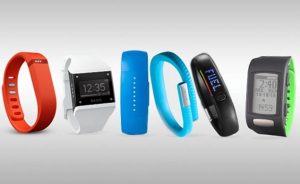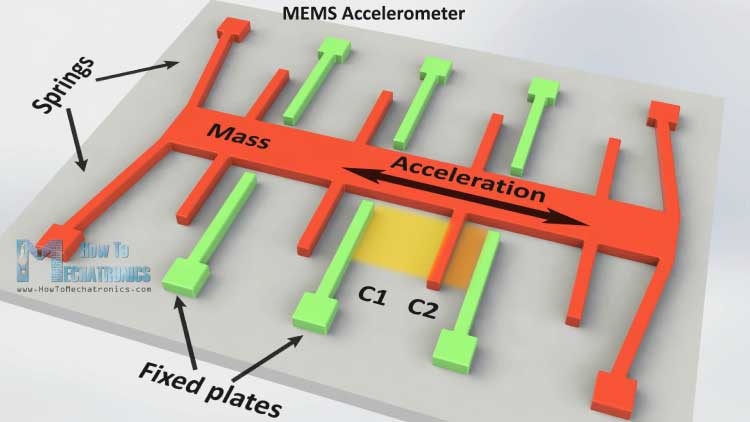Most often, people use Fitness trackers for keeping track of their fitness activity, set achievable goals and to motivate themselves. Fitness trackers are mostly wearable electronics that measure/track your activity such as steps taken, distance walked, calorie consumption and even heart rate in some cases. Most fitness trackers have an accelerometer that helps in tracking our activity. Some fitness trackers may also have altimeter, music player and many other features. So, how does the fitness tracker do it?

Fitness trackers
Accelerometers
Accelerometers are present in almost all the everyday devices that we use from phones, laptops, car, airplanes, and rockets and of course in the fitness tracker too. ‘Accelero’meters are tiny, micro electromechanical systems (MEMS) that are capable of sensing acceleration. How do they sense acceleration? It is by measuring force (Force = Mass * acceleration).

MEMS Accelerometer
So, how does it measure Force then? The accelerometer has a mass (not very bulky) that is suspended, but attached to fixed support using springs inside a casing. The mass is suspended between fixed metal electrodes and mass moves when the casing is disturbed. When the mass moves between the electrodes due to a force, there is a change in capacitance directly proportional to the force. Therefore, every time you take a step, you tilt the fitness tracker and the mass is disturbed and capacitance change is measured. Therefore ultimately, the capacitance is measured which is a measure of force, which is in turn a measure of acceleration.
Well, how can the fitness tracker measure the distance travelled, calories burnt, heart rate in some cases? The answer is it doesn’t. The accelerometer only measures the acceleration directly. All other features such as distance travelled, calories burnt are all derived from the acceleration using certain algorithms. A signal conditioning circuit has algorithms to identify a step, number of steps taken, distance travelled, calories burnt from the acceleration it measured. There is a lot of room for error since the accelerometer may mistake activity like opening a door as a step. Therefore, there is a good margin of error while calculating your calorie count. In fact, some studies have found up to 23% error in measurement of calorie count. For heart rate calculation, there is PPG (PhotoPlethysmoGraph) sensor that calculates heart rate by measuring pulse on the wrist non-invasively using light.
How can all of this fit into a small wrist band? That is definitely an engineering marvel and it is all because of the power of MEMS. Micro-level fabrication techniques allow electromechanical systems to be made in sizes smaller than size of rice grains. The mass and other structures are just silicon substrates, that are etched using chemicals and the metal is deposited on them wherever necessary.

World’s smallest commercial 3-axis accelerometer
So, next time you are going for a jog, look at the mini engineering marvel with awe and use them with satisfaction, now that you know how it works.
Sources and References
https://www.youtube.com/watch?v=KZVgKu6v808
https://goo.gl/rEiijN
http://www.explainthatstuff.com/accelerometers.html
https://goo.gl/JDYruw
https://goo.gl/KxMt2r
